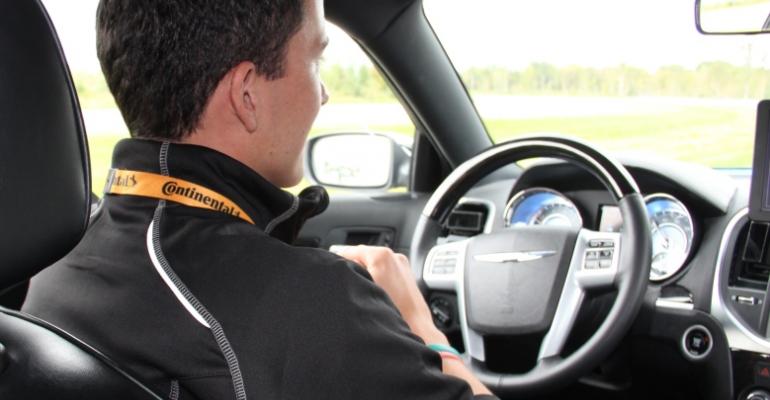BRIMLEY, MI – In the driver’s seat of a test vehicle, Continental validation engineer Steffan Hartmann accelerates to 60 mph (96 km/h), activates the adaptive cruise control and automatic lane-keeping systems and then takes his hands off the steering wheel.
And keeps them off during a long loop around a track at German auto supplier Continental’s 540-acre (216-ha) test facility here in a remote part of Michigan’s Upper Peninsula.
As Continental’s latest version of a highly automated concept vehicle, dubbed Cruising Chauffeur, drives itself, Hartmann tents his fingers in front of him. He looks like he is either a) praying the car will stay on course, or b) showing yoga-like serenity the car will do just fine on its own.
The latter becomes the case, as the vehicle effortlessly rounds corners, slows for a car ahead and changes lanes when Hartmann flicks the turn signal. Various visual alerts keep the non-driver in the driver’s seat informed about what’s going on.
“We’re still experimenting, but the goal is to keep the HMI (human-machine interaction) simple,” says Hartmann.
“Automated driving is a complex system, but we have to make it simple for the end consumer,” says Tom Kenny, a Continental project manager, riding in the backseat of the outfitted Chrysler 300 sedan showing its stuff on the test track.
A global project for Continental, the Cruising Chauffeur concept vehicle controls all driving-related tasks. It relies on 360-degree long- and short-range radar, cameras, integrated active-safety technology and a redundant architecture system. The latter means systems can back up each other in the event of a failure.
The self-driving demonstration is part of a media program showcasing Continental’s advanced technology, much of it centered on autonomous vehicles and safety. The two go together, says Jeremy McClain, the company’s head of Systems & Technologies/Chassis & Safety in North America.
“More than 90% of vehicle accidents are caused by human error, so if we can take (certain functions) away from the driver and provide more information with better sensors, it will help us get us to our vision of zero fatalities.”
Many automakers share that vision. Volvo and Infiniti in particular say they’re ambitiously working toward their zero-fatalities goal. “There are 1.25 million traffic fatalities a year worldwide and 35,000 in the U.S., and that’s just not acceptable,” McClain says.
Many companies, from automakers to suppliers to technology giants such as Google, are working on their versions of self-driving vehicles.
Continental is proceeding with care and a sensitivity to the marketplace. “If we went directly to highly autonomous, people would have a hard time accepting that,” says Jeremy Tuggle, a systems concept manager for the supplier. “We need to bridge it.”
The company sees the technology for highly automated driving to be ready by 2020 and for fully automated driving by 2025, says regional communications manager Mary Arraf.
A new Kelley Blue Book survey indicates autonomous vehicles remain a mystery to many Americans. Several people polled say they’re fine with cars of today, and leery of self-driving cars of tomorrow.
In 2012, Continental was the first automotive supplier licensed to test automated vehicles in the state of Nevada. The company began working on automated driving in 2006.
Cruising Chauffeur – the most recent result of that work and lessons learned from it – can monitor blindspots, keep a safe distance from the vehicle ahead, control cornering speeds and react to other cars moving into its lane. Positioned interior cameras also can monitor driver alertness, although that wasn’t part of the Brimley demonstration.
Systems that were on the program include:
- MK C1 electronic brake system paired with off-road cruise control. Demonstrated in a Jeep on a rocky incline, the system handles braking and engine torque power both uphill and down. All that’s left for the driver to do is steer.
- Dynamic eHorizon Road Database. It uses cloud-based connectivity and vehicle sensors to gather “crowdsourcing” information about road conditions to provide real-time mapping, seen as an integral element of autonomous driving.
“It pulls information from cars with wireless technology, filters that information and creates a mapping data base,” says senior engineer Zach Bolton. “If there are lane closures or construction road barriers, the system will know it.”
- Dynamic eHorizon Traffic Assist. It tells a driver when a traffic light ahead will change from red to green and vice versa. It uses predictive algorithms and traffic light-vehicle wireless systems to do that and to recommend coast speeds to hit green lights. “Even the slightest speed adjustment can make a difference,” says engineer Alex Stege.
- V2X Communication and Cooperative Road User Protection. It’s a combined safety system that uses transmitters to alert drivers of potential dangerous situations (such as a pedestrian about to walk into the path of a vehicle from behind a parked car) that a camera or radar sensor wouldn’t pick up. It requires both the vehicle and the “participant” to have a transmitter, be it in, say, a pedestrian’s smartphone or a road worker’s helmet.
“We’ll never get to (zero fatalities) without the ability for sensors to detect what’s around corners or behind road berms,” McClain says.





